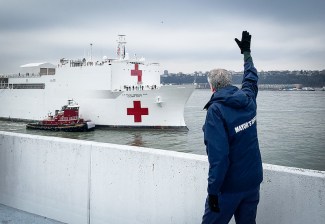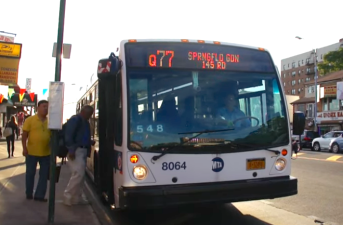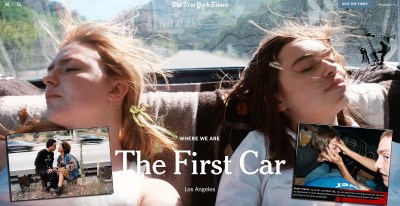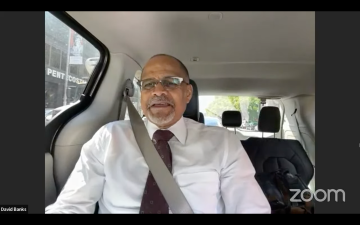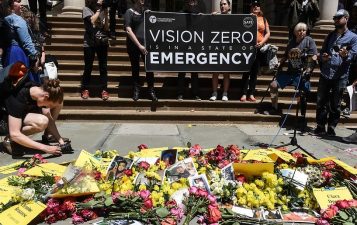Op-Ed: Skip the Victim-Blaming on Bike Lanes, New York Times!
Health columnist Jane Brody, usually a beacon of sense, gets city cycling badly wrong, a traffic expert says.
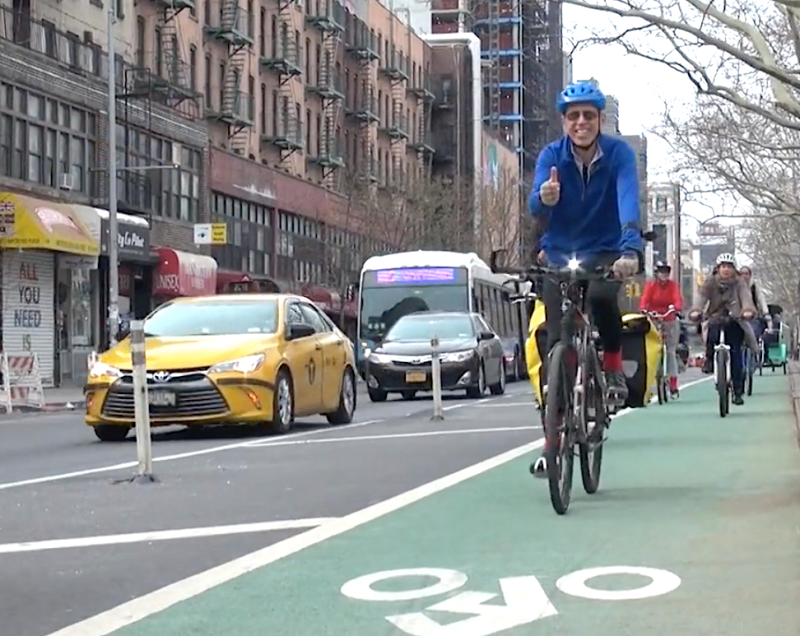

Jane Brody, who regularly writes on personal health for the New York Times, is one of my go-to columnists. So I was dismayed when she recently wrote a misinformed screed against bike lanes — so dismayed, in fact, that I have annotated the column with my comments.
Let’s go through it point by point (inset passages are Brody’s own words, edited where necessary):
“In just the last eight months, I’ve had two cycling
accidents[crashes] when inattentive drivers made right turns and cut me off. So far I’ve been lucky, escaping with bloody scrapes and a bent bike wheel. But I can’t help wondering how long my luck will last.”
The word is “crashes.” An “accident” is when you slip on a banana peel.
“According to data compiled by The New York Times and published earlier this month, in New York City alone last year, 124 pedestrians and 28 cyclists were killed, and more than 10,000 pedestrians and more than 4,000 cyclists were injured despite attempts by the current city administration to make both activities safer.
“With a growing number of inexperienced cyclists taking to the streets since the coronavirus outbreak, the number of
accidents[crashes] had gone up by 31 percent as of March 22, though reduced vehicular traffic and shelter-in-place rules may avert a further increase.”

“Changes have been made at many dicey intersections in New York City to give pedestrians more time to cross before cars can proceed, and there’s been a significant increase in bike lanes, including ones that are supposed to protect cyclists from traffic. More about that in a moment.
“With respect to my own bike
accidents[crashes], both times I had the right of way. In the first, a truck driver turned right and cut me off as I was about to cross a major street on a green light, and I went down with my bike to avoid being crushed. He didn’t stop and likely never even saw me lying on the ground.”
Not a surprise given the danger of trucks.
“The second driver, at least, stopped, picked me up with my bike, and apologizing profusely, made sure I was not seriously injured. He said he forgot about the bike lane. He put the chain back on the bike, offered to drive me home and stayed with me until I stopped shaking.”
Did you report it? If not, why not? Have you filed an insurance claim? Did you get the driver’s info? What would you have done if you were in a car? How do you expect to change the system if you don’t participate?
“But this second incident left me wondering how sensibly some of the new bike lanes were designed. The relatively new Brooklyn bike lane I was on, like many others, runs between a curb on the right and parked cars on the left.
Cars[Drivers] traveling to the left of the parked vehicles have no clear view of what may be coming along in the bike lane, and cyclists in that lane have limited ability to see a driver who turns right and fails to slow down enough to avoid a collision.”
Research suggests protected bike lanes are safer. Both of your crashes involved drivers who failed to yield. In fact, one was a hit and run. Evidence suggests that mandating slower turning speeds encourages yielding.
“Although there was considerable controversy over the creation of a two-directional bike lane along Brooklyn’s Prospect Park West, at least there are no right turns along that 19-block route. Cyclists are alerted to pedestrian crossings, and pedestrians are warned to look both ways before crossing the bike lane.”
The controversy was caused by a privileged minority, including the then-Department of Transportation Commissioner, who lived on the street. The bike lane is on the left side.
“None of this, of course, is foolproof. Inattentive pedestrians and cyclists have resulted in hits and near-hits, though no fatalities in the lane’s nearly 10-year history.”
So how is the lane not an unmitigated success?
“A similar lane, but only in one direction, along Central Park West from 59th to 110th Streets, has been partially built. After 386 crashes that injured 26 cyclists, 14 pedestrians and 34 motorists and killed one cyclist between August 2018 and July 2019, the local community board wants more protection for all concerned.”
Please clarify. The community board wants a Prospect Park West-style bike lane? You support a two-way bike lane?
“I know I’m not alone in thinking that the relative newness of hordes of cyclists in my city is a big part of the problem. Unlike many European cities, there is no longstanding cycling culture in New York and other American cities. The result is several generations of drivers who don’t even think about sharing the road and looking out for cyclists.”
Odd rhetoric — and wrong. Research suggests that the more people cycle, the safer cycling is. Also, why should we put up with this kind of victim-blaming? It’s like arguing that traffic calming increases road rage — or that domestic-violence victims bring attacks on themselves.
“In New York in particular, this issue is complicated by the fact that pedestrians and cyclists, as well as far too many drivers, routinely ignore red lights. As a cyclist and a driver, I know that pedestrians frequently dart out midblock between parked cars and seem to assume we will be able to stop in time to avoid hitting them.”
And they will continue to do so in a system designed mainly for drivers. This traipses out the old “dart out” canard — like when a 9-year-old kid crosses between the school and the playground and is killed by a speeding driver in an SUV with a bull bar. How is it the kid’s fault?
“A further complication: pedestrians often cross the street, with or without the light in their favor, while staring at their phones or wearing headsets that block the sound of my bell.”
I agree, but recognize that, when I operate a vehicle, the Vehicle and Traffic Law demands that I “shall exercise due care to avoid” collisions.
“Aside from virus-related limitations, I have no plans to stop riding my bike, which I ride in all kinds of weather. In addition to being great exercise, it saves me time shopping for groceries, running errands and getting to appointments without having to use a car.”
Likewise, and you have my full support.
“At the same time, I’m a strong advocate for cyclists learning to protect themselves better. Too many ride in dark clothes, even at night, without lights or helmets.”

Why blame the victim? Why are bicycles even sold without lights?
“The Citi Bike program does not provide helmets, and fewer than half the people I see using the bike share bring their own head protection.”
Studies suggest that bike-share programs do not survive in jurisdictions that require helmets, and that reduces overall cycling which, in turn, reduces safety for the remaining riders.
“The jackets or, in warm weather, shirts I bike in are either bright red-orange or lime green, with helmets and backpacks to match, and there are flashing lights on my helmet and bike. After sunset or when visibility is poor, I wear a reflective vest.”
Fire safety is a useful parallel. Sure, we can remind people not to smoke in bed or use frayed extension cords. But real results happen when we fire-proof buildings and require smoke detectors. People’s mistakes shouldn’t mean a death sentence.
“I take pride in remaining alert. I don’t listen to podcasts or phone calls while riding. If I receive a potentially important cellphone call or text alert, I’ll stop on the side of the road to check it. Otherwise, I ignore it until I get home.”
I agree completely.
“While riding on city streets, I check for cars about to pull out from a parking spot or a vehicle door that might open in my path. I’m especially wary of drivers who seem to be looking for a parking spot. Fifteen years ago, I was knocked down by a driver who passed me, then cut me off when she pulled headfirst into a spot. I use a full-arm signal when I’m about to pull into a traffic lane to get around a double-parked vehicle or other obstruction.”
Likewise.
“When approaching an intersection where cars can turn right, I give drivers on my left the right of way.”
You should swerve to the left a bit so that drivers can see you.
“I no longer assume that because they didn’t signal a turn, they’ll be going straight ahead. Drivers sometimes change their minds at the last moment, and too often I’ve had to stop abruptly or jump off my bike when a driver suddenly decides to turn in front of me.
“I will soon be 79 years old and I’ve been riding a bike in city streets for three-quarters of a century. I hope to be able to continue to do so for at least another decade, though I promise to listen to my aging body if it tells me I’m getting too feeble or careless to do so.
“In the meantime, for the foreseeable future, until most drivers become more respectful of cyclists and the lanes dedicated to them, I plan to avoid riding on so-called protected bike lanes where turning vehicles can’t see me and I can’t see them until perhaps it’s too late.”
Michael King (@movethecurb) is Brooklyn-based transportation planner and urban designer who has worked in 22 countries on five continents, co-authored the NACTO Urban Street Design Guide, and was the first director of traffic calming at the Department of Transportation.
